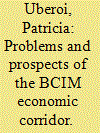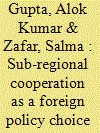| Srl | Item |
| 1 |
ID:
143291


|
|
|
|
|
| Summary/Abstract |
This article takes a critical look at the new Chinese ‘One Belt, One Road’ (OBOR) or ‘Belt and Road Initiative’ (BRI) for 21st century Eurasian connectivity and economic integration from the perspective of the proposed Bangladesh–China–India–Myanmar Economic Corridor (BCIM-EC). The BCIM-EC is a sub-regional cooperation project that aims to link the land-locked provinces of southwest China with eastern India and the Bay of Bengal through northern Myanmar, India’s northeast region, and Bangladesh. However, within months of being mooted in May 2013, the BCIM-EC was yoked to another connectivity initiative, the China–Pakistan Economic Corridor (CPEC), and the two encompassed within President Xi Jinping’s grand vision for a new overland and maritime Silk Road. As of now, India has (i) endorsed the BCIM-EC, (ii) rejected the CPEC and (iii) maintained studied silence on the OBOR initiative per se. Where does that conundrum leave the BCIM-EC? And to what extent, if at all, can India leverage OBOR to its own advantage?
|
|
|
|
|
|
|
|
|
|
|
|
|
|
|
|
| 2 |
ID:
141594


|
|
|
|
|
| Summary/Abstract |
Several factors have acted as bottleneck towards regional integration within South Asian Association for Regional Cooperation (SAARC). It ranges from Indo-Pak hostility and motivated Chinese interventions to ‘big brother small brother’ syndrome within the region. Accordingly, economic integration at the behest of SAARC as a Regional Organization has always been questioned and has largely been rendered failure. South Asia is the fastest growing region in the world. The combined economy of the SAARC countries is the third largest in the world in terms of GDP (PPP), with US and China ahead of it. According to South Asia Economic Focus report brought out by World Bank, regional growth is projected to increase from 7 percent in 2015 to 7.6 percent by 2017 with the increase in investments and steady rise in consumption patterns.
|
|
|
|
|
|
|
|
|
|
|
|
|
|
|
|
| 3 |
ID:
168226


|
|
|
|
|
| Summary/Abstract |
The research puzzle of this article is to understand and explain the process of Iskandar-Malaysia region building. By doing that the article contributes to the debate around how regions emerge and to what extent states have to adapt to, cooperate with, and compete with them. Within the framework of regulatory regionalism and multi-level governance, the paper aims to address one main question: how and to what extent interactions between state and non-state actors that contribute to produce new (cross-border) regional forms may politically and economically reconfigure states' relations. This is the first study on Iskandar-Malaysia that focuses attention on the sub-national border governance that is shaped by the interaction between Singaporean, Malaysian and Johorian private and public actors and which can lead to an internal transformation of the states involved in the process.
|
|
|
|
|
|
|
|
|
|
|
|
|
|
|
|